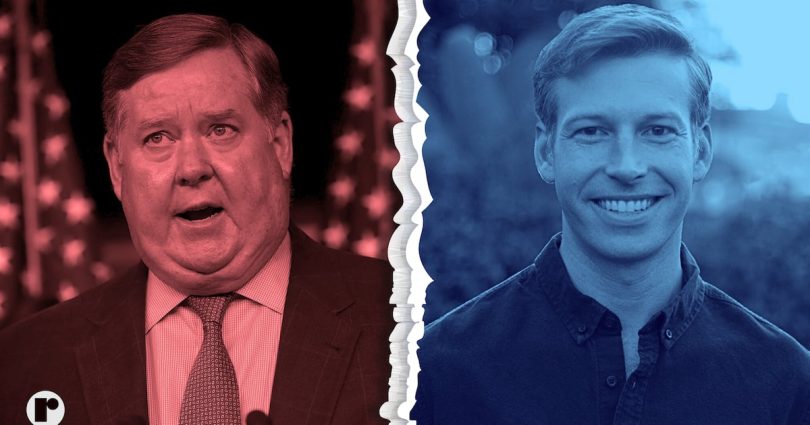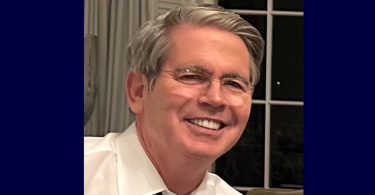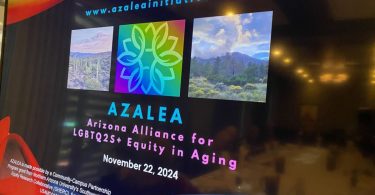This California LGBTQ+ haven is surrounded by conservatives — and it could decide who controls Congress A victory in this election would represent a critical pickup for Democrats, potentially setting the stage for a shift in power that could reshape the legislative agenda for the entire nation. (Alex Wong, Denny Agassi/Getty Images / Associated Press)
California’s 41st Congressional District, an LGBTQ haven surrounded by conservative strongholds, has become an unexpected battleground that could determine control of the House.
In 2022, Republican Congressman Ken Calvert narrowly won the district after redistricting, which came after five-term Democratic incumbent Mark Takano’s move to District 39. Now, in a tight and unpredictable race against openly gay Democratic newcomer Will Rollins, the future of the Congressional District—one that includes the Greater Palm Springs area, an LGBTQ haven—hangs in the balance.
This race offers a fascinating glimpse into how national culture war issues are seeping into local politics, with the incumbent facing a surprisingly close challenge. The district’s unique demographic makeup, a progressive enclave in a sea of conservatism, has turned it into a microcosm of America’s broader political divide.
The 41st District stretches across Riverside County including the cities of Corona, Palm Springs, Palm Desert, La Quinta, portions of Eastvale and Riverside and many more. The district also includes the unincorporated areas of El Sobrante, Woodcrest, Temescal Valley, Lakeview, Nuevo, Homeland, Winchester, Cherry Valley, Anza, Pine Cove and Idyllwild.
Wes Speake, a Corona City Council member and president of the Corona Historic Preservation Society, told the Los Angeles Times in June that Corona saw a shift to the center-left due to an “exponential” increase in diversity over the last two decades, with younger and more liberal arrivals from Los Angeles and Orange counties. Now, Rollins is at the forefront to challenge Calvert, hoping to push the purple district blue.
While the 41st District now includes the LGBTQ-friendly Palm Springs area, it’s surrounded by predominantly conservative regions. To the east, the 25th District, represented by Republican Jay Obernolte, voted for Trump by a 9-point margin in 2020. To the south, the 50th District, held by Republican Darrell Issa, is considered a Safe Republican seat by Cook Political Report. Even within Riverside County, areas outside the 41st District tend to lean conservative, with the county voting Republican in five of the last six presidential elections prior to 2020.
Since California redistricted, looping in major LGBTQ cities, the district shifted the previously Republican-leaning Riverside County map to one with a neck-and-neck share of Democratic voters. With the Greater Palm Springs area now part of the district, registered Republicans make up about 36.3% of voters, while the registered Democrats make up about 36.7% as reported by Spectrum News 1.
This redistricting has transformed what was once a safe Republican seat into a highly competitive district, forcing both candidates to adapt their strategies. The inclusion of Palm Springs and other LGBTQ-friendly communities has not only balanced the voter demographics but also brought LGBTQ issues to the forefront of the campaign, creating a microcosm of national political tensions.
In 2017 alone, Palm Springs elected its first trans City Councilor Lisa Middleton along with bisexual City Councilor Christy Holstege, joining gay City Councilors Geoff Kors and J.R. Roberts along with gay Mayor Robert Moon. This established the first all-LGBTQ Council in Palm Springs history. In 2021, Middleton became the first openly trans mayor of Palm Springs—and first in all of California.
Palm Springs has long been considered an LGBTQ+ haven, with a history of inclusivity dating back to the 1920s when Hollywood’s queer community began frequenting the desert oasis. Today, the city boasts one of the highest concentrations of LGBTQ residents in the country, with an estimated 50% of the population identifying as LGBTQ. This welcoming atmosphere is reflected in the city’s policies and culture: Palm Springs hosts numerous LGBTQ events annually, including one of the largest Pride parades in California, and is home to various LGBTQ-focused community centers and support services. The city has also implemented comprehensive non-discrimination ordinances and offers domestic partner benefits to city employees, further cementing its status as a true LGBTQ+ haven.
In District 41, incumbent Calvert and Rollins are locked in a dead heat. Leading up to Nov. 5, the election could turn the tide in the district, potentially granting the Democratic Party full control of the chamber.
The Republican incumbent and his large LGBTQ population
While there is no data on the LGBTQ population within District 41 overall, California, the most populous state in the nation, remains to be home to many of the country’s queer, trans and nonbinary population at 2.8 million people, making up 9.5% of the state. California leads by a landslide to Texas, who is second on both counts with an LGBTQ population of 1.8 million.
This is according to several reports provided to Reckon by Steven Bliss and Hans Johnson at the Public Policy Institute of California, in addition to a report from this June conducted by Household Pulse Survey, an initiative of the US Census, from February through April. The data reveals that over half of LGBTQ adults in California describe themselves as bisexual, 42% describe themselves as gay or lesbian and 6% as trans.
Currently, Congressman Calvert is one of 12 Republican congresspeople, with Democrats holding 40 district seats.
In need of a win, trans people struggle in the sea of a seemingly LGBTQ haven
David L. Gray and Julie Warren, the co-founders and co-directors of LGBTQ+ History & Archives of the Desert whose mission is to collect, preserve and share the history of queer and trans history in Coachella Valley, shares with Reckon that the LGBTQ community of the enclave is rich in history.
In 1976, Christine Jorgensen, the first American woman to publicly announce her gender reassignment surgery, spoke at a Palm Desert Women’s Club Luncheon at the Desert Club—now demolished and is the site of Fritz Burns Park—in La Quinta. The Brigg’s Initiative, a ballot initiative introduced in 1977 that would have banned gay and lesbian people from teaching and working in public schools was defeated by November 1978. In 2014, the Transgender Community Coalition was formed, and the National Transgender Day of Remembrance was celebrated for the first time locally at Francis Stevens Park in Palm Springs.
Despite the landmarks and waves the transgender community has made in the Greater Palm Springs area, Thomi Clinton, the CEO and founder of the Transgender Health & Wellness Center, says that trans constituents remain to be the overlooked in community care. Clinton’s center is the area’s leading experts for the community, with over 7,000 people in their database who have been tended to.
A database from nearly a decade ago by Funders for LGBT Issues revealed that trans-led organizations received only 0.015% of every dollar given to LGBTQ organizations—or a penny for every $100 that foundations awarded.
“Do a quick search of LGBTQ organizations and see how many are run by cisgender gay men—mostly cisgender, gay white men,” Clinton explained, noting that organizations like hers that are dedicated to serving the transgender population of LGBTQ constituents end up with little to no resource. “It’s a cisgender white male-dominated economy when it comes to equality.”
According to Clinton, neither candidate for District 41 has made efforts this year to meet with their LGBTQ constituents. Still, she believes that Rollins’ win could signify greater change.
What Rollins’ win could mean
Based in Riverside within the district, Benjamin Bishin, professor of political science at the University of California Riverside, shares that incumbent Calvert is “somewhat out of touch” with how competitive the district has become.
“He is also not very well liked,” he added. “Rollins appears to be a very solid candidate and a pretty good fit for that district given he has worked with Republicans in the past.”
Bishin tells Reckon that his expectation given the combination of the district in this particular cycle should slightly favor Rollins, whose close win against Calvert during the general election enabled him to raise a great deal of money this year. A win for Rollins, additionally, could be highly significant.
That is, according to John J. Pitney Jr., the Roy P. Crocker professor of American politics at Claremont McKenna College.
“Calvert is what they call a ‘district guy,’” Pitney Jr. explained. “As a member of the Appropriations Committee, he has focused on supporting federal spending for Southern California. He was not primarily a culture warrior, but neither was he an advocate for LGBTQ rights.”
Historically, Calvert supported the Defense of Marriage Act, a federal statute that defines marriage for all federal purposes as a legal union between one man and one woman—rendered unenforceable in 2013 and 2015. It is worth noting that since the change of district, he was one of 39 House Republicans to support same-sex marriage during the Respect for Marriage Act in 2022—something LGBTQ community members are weary of as a desperate attempt to win back votes this November.
Meanwhile, Pitney Jr. shares that a Rollins victory would be highly significant. He believes that because Republicans have a very narrow majority in the House, any Democratic pickup would be a big step toward flipping control of the chamber.
The current balance of power in the House of Representatives is extremely tight, with Republicans holding 222 seats to Democrats’ 213. This means Democrats need to flip just five seats to gain a majority. Given this razor-thin margin, the outcome of the race in California’s 41st District could indeed be pivotal in determining which party controls the House after the 2024 election. A Rollins victory here would represent a critical pickup for Democrats, potentially setting the stage for a shift in power that could reshape the legislative agenda for the entire nation.
With majority status comes control of the agenda and all committee chairs.
“A Democratic majority would be much more receptive to the LGBTQ community than a Republican majority,” he said.
A Democratic-controlled House could potentially advance significant LGBTQ legislation like the Equality Act, which would prohibit discrimination based on sexual orientation and gender identity in various sectors of public life. Additionally, it might lead to increased funding for LGBTQ health initiatives and stronger protections for transgender individuals, demonstrating how this single race could have far-reaching implications for LGBTQ rights at the federal level.
As a gay candidate, Rollins is unwavering in his criticism of Calvert’s anti-LGBTQ voting history, regardless of his recent changes since the redistricting. Rollins told The Washington Blade this June that his leadership would be a danger to the LGBTQ community of District 41 at large.
“[Calvert’s] votes don’t just impact the LGBTQ community—because obviously they have hurt our community over the years—but they’ve actually hurt every American.”







